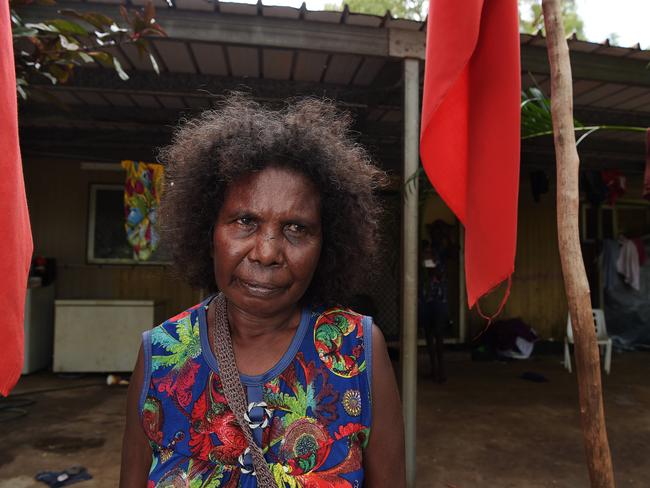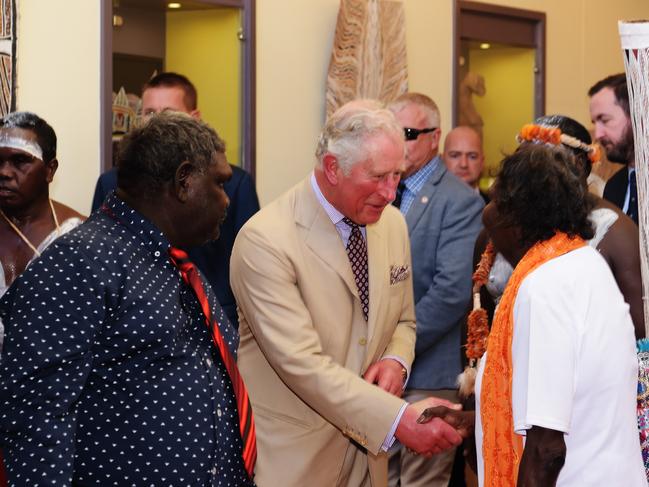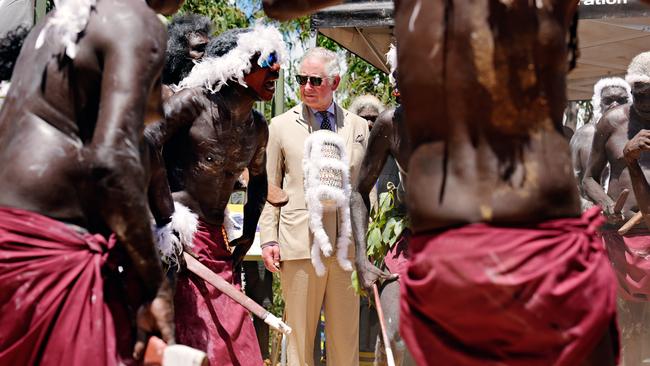AS Prince Charles meanders calmly through an Arnhem Land art centre, 30km away a pair of red funeral flags hang out front a doorway.
After a sustained illness, Susan Gurruwiwi’s husband succumbed to blood cancer in February. The red cloth represents his Dhalwangu clan.
The family continue to wait for the funeral. Ms Gurruwiwi continues to grieve. Nearby, in the same yard, young mother Teresita Wunungmurra clutches her tiny bub.

“We all help each other,” she says.
It’s daily life and death in East Arnhem Land — sights beyond the tightly orchestrated operation shown to the future king of the Commonwealth during his whirlwind visit to the region on Monday.
NT Fisheries employee James Wunungmurra, 24, also lives in this three-bedroom house on the outskirts of Gunyangara (Ski Beach) community, with 11 family members staying between its walls.
The age range of Mr Wunungmurra’s housemates stretches from a baby to the elderly Ms Gurruwiwi.
While he says it was “good to see him around the remote area,” the care factor of his family about Prince Charles’ visit wasn’t particularly high.
“Some people they do care about Prince, and some, I don’t know,” Mr Wunungmurra says.
His Royal Highness would do well, he says, to return and spend a day in his shoes.
“It’s up to the Prince if he wants to stay for longer, or a day.
“I’ll show him what I do — like go out fishing, that’s what I normally do, that’s my job. Go out fishing, catch some fish and bring it to the shops. And all the leftovers I give it to my families — old people around the communities.”
As the future king of indigenous heartlands across the Commonwealth, Prince Charles is, by accounts, quite well-versed on his wide patch. When he flew into the Gove Peninsula he was perceived by those who met him as good humoured, kind and curious.
British Royal photographer Tim Rooke, who has been shooting the family for 25 years, says the Prince’s hefty travel schedule plays a part in his dexterous dealings with many different races.
“We go to lots of (places). Because we go to Canada, New Zealand, we go to meet lots of indigenous people all over the world,” Mr Rooke says.
Just two days before the Prince and his entourage touched down at Gove Airport, they had flown from Australia for a fly-in, fly-out visit to the Pacific Island nation of Vanuatu for ceremonies. They were back in Far North Queensland by nightfall the same day.
But what do he and his fellow royals get from these lightning quick glimpses of lands as deep as the turquoise waters surrounding them?
“I don’t know if they understand. There’s a lot of cultural things going on,” Mr Wunungmurra says.
■ ■ ■
THE Yolngu of East Arnhem Land know how to put on a show.
The coastal community of Yirrkala is no stranger to a visiting dignitary of high stature or importance, with Prime Ministers Julia Gillard, Kevin Rudd and Tony Abbott all dropping by in recent years. Malcolm Turnbull is yet to follow suit — although he did travel to the nearby Garma festival in 2017.

Local landowners were more than ready for the high-profile royal as he breezed in on Monday for his heavily micromanaged whirlwind into the region.
In the Buku-Larrnggay art centre, Prince Charles radiated the vision of a polite, elderly gent soaking in an exotic universe around him. A relaxed scene, except, that is, for the buzzing hive of British minders, international press and government dignitaries all tailing the nearly 70-year-old figure as he slowly wove his way through the collection of works.
The Yolngu brought their best for the occasion.
As Gumatj elder Balupalu Yunupingu put it: “We want to give him something back. Something that he will take back with him to the royal family.”
And this was surely achieved. The many clans of East Arnhem Land offered up a dazzling menu of cultural highlights to entertain the heir to the throne, from traditional bunggul to artistic showcases and a spiritual blessing from a didgeridoo.
But they also gave him a message, a message that many more than three Australian Prime Ministers have failed to heed.
The region’s member of Territory Parliament Yingiya Mark Guyula presented Prince Charles with a “letter stick” at the Yirrkala event, pleading for Buckingham Palace to help see a treaty installed.
“We have many difficulties with the Australian Governments because they do not recognise our sovereignty,” the message read.
“We need to correct this situation, for the sake of our children and their children, for our cultural survival, for our ancestors. We are the oldest living culture in the world.
“We are the only indigenous people of a Commonwealth country that does not have the respect or dignity of a treaty with our people.”
Aboriginal Australians were first promised a treaty by Bob Hawke at the Barunga Festival, about 600km from Yirrkala as the crow flies, 30 years ago.
After decades of government inaction and last year’s failed attempt to see an indigenous voice installed into parliament, bypassing the heads of Australia to the next rung up the hierarchy seemed to make perfect sense. Mr Guyula asked Prince Charles to pass the message on.
“Will you advocate on our behalf for our justice?” his message continued.
“Please … create a diplomatic passage for this letter stick from your highly respected position to the Prime Minister of Australia, in order to help our sovereign nations reach treaty.”
By Mr Guyula’s account, the Prince accepted the barbed plea about successive Australian Governments’ failure to act on a treaty “graciously”.
The following day, with the royal exited and already onto the next orchestrated string of activities in Darwin, Mr Guyula reflected on the message he gave to Charles from East Arnhem Land.
“There was the impression that we were trying to manipulate him or force him to fight for us — but it’s not,” Mr Guyula says.
“We gave him that message stick because we respected him, that he’s highly respected, and that’s why we asked for help and support, from him.”
But will the message get anywhere? Or will it prove no more than a faint cry from one the nation’s remotest corners, aimed at a federal government but delivered to a faraway Prince during a brief, whirligig of a stopover?
■ ■ ■
■
Out in Yirrkala, and indeed Aboriginal communities across the Northern Territory, daily survival has little if anything to do with the inner workings of Clarence House, the royal whispers of Fleet Street or the Union Jack still flapping in the corner of the Australian flag.
Perhaps the strongest connection which exists between the British monarchy and those on the ground are the dollar coins with the Queen’s head still carved into them.
When artist Kevin Namatjira was offered a rare meeting with Queen Elizabeth II, due largely to his being the grandson of famed watercolour painter Albert, all the Hermannsburg man wanted to ask was for Her Majesty to assist with his housing situation.
“I’ve been kicked out from my house … I’d like she could help me get land,” Mr Namatjira said.
“For a little house. When we buy anything, back in Alice Springs, they grab them, the police.
“They got, police got Queen’s crown (on their uniforms).”
Despite the barriers of language and land, for decades a longstanding, well-intentioned but slightly bizarre relationship has been forged between the British royals and remote and outback Australia.
From Princess Diana and Charles’s unexpected stay in Alice Springs to Prince William and wife Kate meeting Mutitjulu mob at Uluru, the residents of Buckingham Palace have long been known to enjoy a sightseeing stopover on the Territory’s red soil.
But once they’re gone, what have their visits brought to the communities in which they have dropped by to shake many hands?
For some, at least, the feeling of connecting with the royals has had true impact.
An interaction between Prince Charles and yidaki master Djalu Gurruwiwi inside Yirrkala’s art centre on Monday, after the elder played a blessing for the royal, left his family shaking.
“We was nearly crying. In our hearts we were crying. Somehow we connected,” said Djalu’s daughter Zelda Gurruwiwi.
For others, however, it’s hard to know what all the fuss is about.
On Yirrkala’s Beach Camp, a family busies itself around a grill plate heating over charcoals, ready to cook up a few steaks while staring out to the Arafura Sea.
An elderly woman, who asked not to be named for this article, talks to the NT News about the commonplace reality of power blackouts, overcrowding and drunks.
When asked about Prince Charles’ visit, she scoffs.
“What, he’s gonna make the world change here, for Yirrkala?” She laughs. “Nah. I don’t think so.
“Just some important guy travelling through, has no idea about Yolngu communities, how we live.”
She says it’s time for Australia to make steps towards a republic.
“Go independent … I don’t think the Commonwealth has helped much, indigenous people in this country. We’re still under their law — monarchy.”
According to a poll conducted by News Corp this week, the move may prove difficult, at least during this generation. Australian opposition to ditching the monarchy has swelled to 41 per cent from 38 per cent last year.
Yingiya Guyula believes cutting ties with the British royals won’t make a shred of difference for the Yolngu. Not without a treaty.
“It doesn’t really matter whether we go on republic or go away from monarch, long as we are recognised, and we are a sovereign people,” he says. “That is the space that we are asking for. We are not asking for a republic or go without the monarch. It’s a space where we need to be recognised that we were people here.”
Welcome to a country fit for a Prince, but where many of the world’s longest living culture remain on the breadline, unable to have their voices heard above the din.


Add your comment to this story
To join the conversation, please log in. Don't have an account? Register
Join the conversation, you are commenting as Logout
‘Treated like animals’: Death in custody warning over watch house
Women are allegedly being crowded into cells in view of masturbating men at the Territory’s police watch house. WARNING: Distressing images.
Mental health advocate uses personal pain as strength
The award-winning mental health facilitator and advocate is passionate about breaking cycles of violence and is not afraid to use her own painful story to do it.